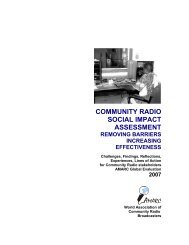Introduction◆◆◆◆Sasa Lazarevic, <strong>of</strong> RTV Bosnia-Herzegovina, was one <strong>of</strong> thefirst reporters to cover theSerbian shelling <strong>of</strong> Sarajev<strong>of</strong>rom the barricades. He was hitby shrapnel and killed on June20 1992.Gordan Lederer, a Croatian televisioncameraman, died onAugust 10 1991 en route to hospitalafter filming a battle outsideKostajnica. He was hit by asniper and then by a mortarround, but the Yugoslav armywould not allow a helicopter totake him to Zagreb.Zoran Amidzic, a camera crewmember for Belgrade television,died with three others onOctober 9 1991 when their carwas hit by a mortar round nearPetrinja, south <strong>of</strong> Zagreb.Belgrade radio blamed theattack on Croat forces.Kerem Lawton, 30, a Britishproducer for Associated Presstelevision news, was mortallywounded on January 29 2001 inKrivenik,Yugoslavia. Lawtonand cameraman, SyllejmanKlokoqi, were covering thedeployment <strong>of</strong> NATO peacekeepersalong the Kosovo-Macedonia border. Klokoqi gotout <strong>of</strong> the car to film refugees.The car was hit by mortar fire.Lawton’s wife was pregnantwith their first child.who cheat, rob and inflict violence on their communities, so thatthey can avoid exposure and stay in the shadows.The deaths <strong>of</strong> international correspondents such as Daniel Pearl,the Wall Street Journal reporter who was abducted and murdered inPakistan in 2002, Raffaele Ciriello, the Italian photographer whowas killed by Israeli machine gun fire in central Ramallah in March2002, and Kurt Schork and Miguel Gil Moreno, who were killed inSierra Leone in May 2000, become news events themselves.However, it is important to recall that <strong>of</strong> the 1,192 journalists killedsince 1990, more than 90% were born and grew up in the landwhere they died. Foreign correspondents are the high-pr<strong>of</strong>ile casualties,but most victims are local. When the victim is a journalistworking in his or her own community, the news makes littleimpact elsewhere. Local journalists are at greater risk because theycontinue to live in the areas from where they report. When thestory is over, they cannot board an aeroplane and fly away.This manual is primarily aimed, therefore, at journalists andother members <strong>of</strong> the news gathering team working in their owncountry or region. Such journalists and camera crews are usually ata disadvantage compared to those who fly in from overseas. Localcorrespondents, camera crews and photographers may have to takemore risks with little or no support for themselves or their familiesif something goes wrong. They do not have the insurance or equipmentor backup <strong>of</strong> international correspondents working for largemedia networks, and they are less likely to have been sent on atraining course. Some international teams even hire local journaliststo take their risks for them, without <strong>of</strong>fering the same level <strong>of</strong>protection as they provide for their own staff.Part <strong>of</strong> the answer lies in the growing campaign for equal rightsfor staffers and freelances and for better equipment, training andinsurance. This is particularly needed for freelance staff, many <strong>of</strong>whom are dependent on one title or channel, but who are entitledto none <strong>of</strong> the protection <strong>of</strong>fered to staff members. One objective <strong>of</strong>this book is to raise the awareness <strong>of</strong> journalists, journalists’ organisationsand media employers for the need for greater protection. Itforms part <strong>of</strong> a general demand that those who own and run thenews media take more responsibility for the safety <strong>of</strong> their journalistsand for the welfare <strong>of</strong> their families. Greater legal protectionfor freelance journalists should be high on the agenda in all negotiationswith employers.However, there is also much that journalists and other media2
<strong>Live</strong> <strong>News</strong> — A <strong>Survival</strong> <strong>Guide</strong> for <strong>Journalists</strong>workers can do for themselves and for each other to increase safetyand reduce risk. <strong>Journalists</strong> on hazardous assignments can look outfor each other, even if they work for ‘rival’ news organisations.<strong>Journalists</strong> also need to understand how inflammatory journalismand poor standards <strong>of</strong> reporting can have consequences for all journalistsby souring relations with local groups and institutions.People who target the media with violence do not distinguishbetween ‘good’ or ‘bad’ journalists; they hit out at those they canreach. All journalists have a physical stake in high standards andobjective reporting, even if this alone will not guarantee safety.The importance <strong>of</strong> safetySafety is a positive quality, part <strong>of</strong> getting the job done well andquickly; an asset, not a liability. A good journalist cultivates safetyawareness, just as he or she develops interviewing and investigationskills. Safety means thinking ahead, being prepared, observingwhat is happening and reflecting on its meaning. A good driverreads the road; a fast driver reads the speedometer.The job <strong>of</strong> the journalist is to tell the story, not to become thestory. A journalist who puts him or herself needlessly at risk isbehaving in an unpr<strong>of</strong>essional manner; one that could ultimatelyprevent the story being told or the picture being seen. Some correspondents,photographers and camera operators in war zonesembrace a macho culture and a competitive urge for danger. Butgood journalism is about delivering reliably, not about getting anadrenaline high. In any case, journalists who adopt an attitude <strong>of</strong>‘death or glory’ usually focus on the glory rather than on death,and hardly think about the serious injury that could end theircareers. In the meantime, reckless journalists put at risk the lives<strong>of</strong> the fixers, drivers and interpreters who make it possible for themto work. And sometimes the risks can be for nothing. Getting closerto the action does not always make for better reporting or morecompelling film.Is any story or picture worth dying for? Even the best stories andpictures only have value when they are read or seen. Moreover, ajournalist who is killed or injured cannot file a story or process apicture. A live journalist is infinitely more effective than a deadone. And while nobody can remove all the danger from the pr<strong>of</strong>ession,journalists can do much to anticipate dangers, reduce risksand come through hazardous assignments safely. <strong>Journalists</strong> havean individual responsibility to anticipate and reduce dangers, and3
















